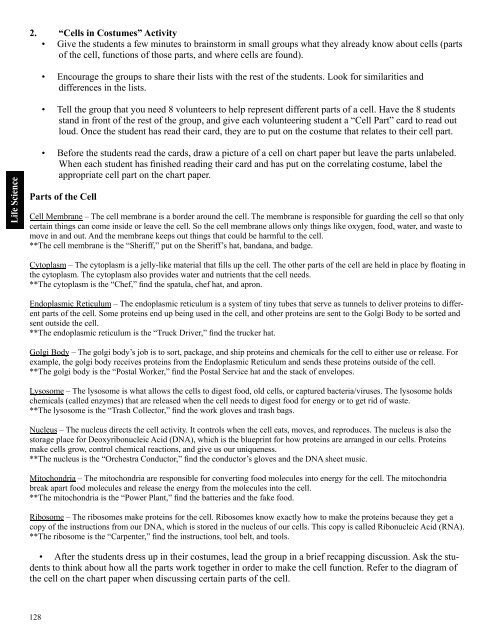ScienceMakers Toolkit Manual - The History Makers
ScienceMakers Toolkit Manual - The History Makers
ScienceMakers Toolkit Manual - The History Makers
You also want an ePaper? Increase the reach of your titles
YUMPU automatically turns print PDFs into web optimized ePapers that Google loves.
Life Science<br />
2. “Cells in Costumes” Activity<br />
• Give the students a few minutes to brainstorm in small groups what they already know about cells (parts<br />
of the cell, functions of those parts, and where cells are found).<br />
128<br />
• Encourage the groups to share their lists with the rest of the students. Look for similarities and<br />
differences in the lists.<br />
• Tell the group that you need 8 volunteers to help represent different parts of a cell. Have the 8 students<br />
stand in front of the rest of the group, and give each volunteering student a “Cell Part” card to read out<br />
loud. Once the student has read their card, they are to put on the costume that relates to their cell part.<br />
• Before the students read the cards, draw a picture of a cell on chart paper but leave the parts unlabeled.<br />
When each student has fi nished reading their card and has put on the correlating costume, label the<br />
appropriate cell part on the chart paper.<br />
Parts of the Cell<br />
Cell Membrane – <strong>The</strong> cell membrane is a border around the cell. <strong>The</strong> membrane is responsible for guarding the cell so that only<br />
certain things can come inside or leave the cell. So the cell membrane allows only things like oxygen, food, water, and waste to<br />
move in and out. And the membrane keeps out things that could be harmful to the cell.<br />
**<strong>The</strong> cell membrane is the “Sheriff,” put on the Sheriff’s hat, bandana, and badge.<br />
Cytoplasm – <strong>The</strong> cytoplasm is a jelly-like material that fi lls up the cell. <strong>The</strong> other parts of the cell are held in place by fl oating in<br />
the cytoplasm. <strong>The</strong> cytoplasm also provides water and nutrients that the cell needs.<br />
**<strong>The</strong> cytoplasm is the “Chef,” fi nd the spatula, chef hat, and apron.<br />
Endoplasmic Reticulum – <strong>The</strong> endoplasmic reticulum is a system of tiny tubes that serve as tunnels to deliver proteins to different<br />
parts of the cell. Some proteins end up being used in the cell, and other proteins are sent to the Golgi Body to be sorted and<br />
sent outside the cell.<br />
**<strong>The</strong> endoplasmic reticulum is the “Truck Driver,” fi nd the trucker hat.<br />
Golgi Body – <strong>The</strong> golgi body’s job is to sort, package, and ship proteins and chemicals for the cell to either use or release. For<br />
example, the golgi body receives proteins from the Endoplasmic Reticulum and sends these proteins outside of the cell.<br />
**<strong>The</strong> golgi body is the “Postal Worker,” fi nd the Postal Service hat and the stack of envelopes.<br />
Lysosome – <strong>The</strong> lysosome is what allows the cells to digest food, old cells, or captured bacteria/viruses. <strong>The</strong> lysosome holds<br />
chemicals (called enzymes) that are released when the cell needs to digest food for energy or to get rid of waste.<br />
**<strong>The</strong> lysosome is the “Trash Collector,” fi nd the work gloves and trash bags.<br />
Nucleus – <strong>The</strong> nucleus directs the cell activity. It controls when the cell eats, moves, and reproduces. <strong>The</strong> nucleus is also the<br />
storage place for Deoxyribonucleic Acid (DNA), which is the blueprint for how proteins are arranged in our cells. Proteins<br />
make cells grow, control chemical reactions, and give us our uniqueness.<br />
**<strong>The</strong> nucleus is the “Orchestra Conductor,” fi nd the conductor’s gloves and the DNA sheet music.<br />
Mitochondria – <strong>The</strong> mitochondria are responsible for converting food molecules into energy for the cell. <strong>The</strong> mitochondria<br />
break apart food molecules and release the energy from the molecules into the cell.<br />
**<strong>The</strong> mitochondria is the “Power Plant,” fi nd the batteries and the fake food.<br />
Ribosome – <strong>The</strong> ribosomes make proteins for the cell. Ribosomes know exactly how to make the proteins because they get a<br />
copy of the instructions from our DNA, which is stored in the nucleus of our cells. This copy is called Ribonucleic Acid (RNA).<br />
**<strong>The</strong> ribosome is the “Carpenter,” fi nd the instructions, tool belt, and tools.<br />
• After the students dress up in their costumes, lead the group in a brief recapping discussion. Ask the students<br />
to think about how all the parts work together in order to make the cell function. Refer to the diagram of<br />
the cell on the chart paper when discussing certain parts of the cell.










